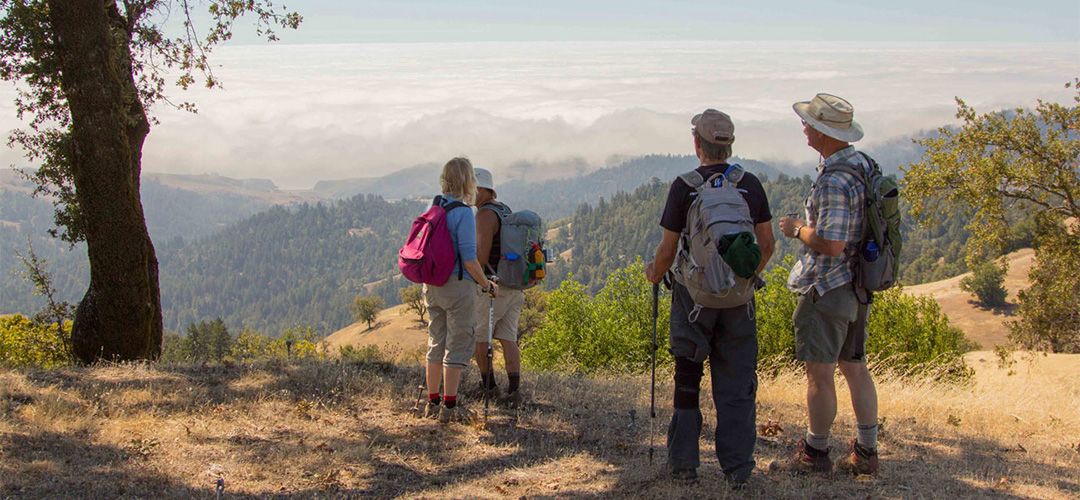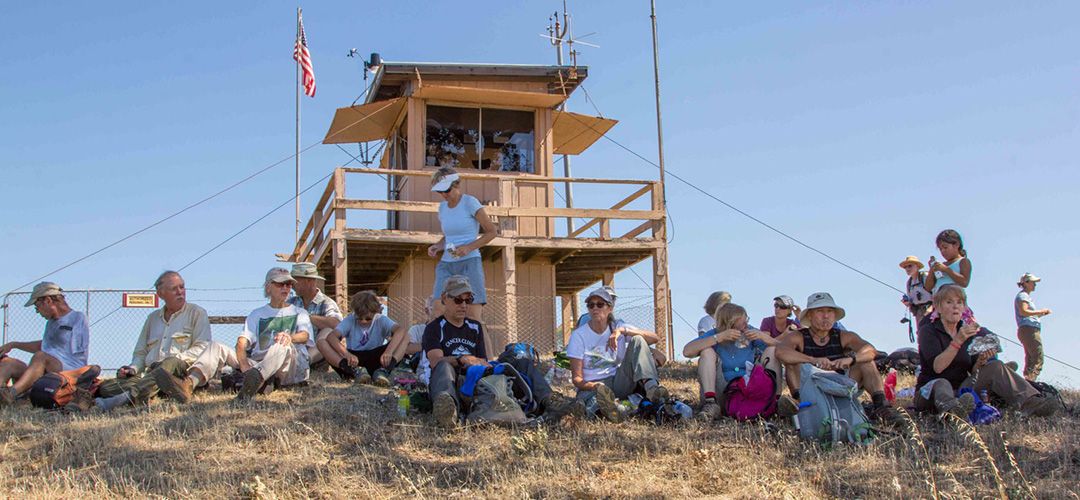POLE MOUNTAIN
Property Type
Anchor Preserve
Acreage
238
Protected in
2014
Region
Sonoma Coast

The Tallest Point Along Our Coast
From the top of the highest peak along the Sonoma Coast are unobstructed, 360-degree views of Sonoma County and beyond. Pole Mountain, sitting between Jenner and Cazadero, stands above a blanket of ridges and presents crystal-clear views in all directions — the Pacific Ocean in the west, exquisite views of the Cedars and Wine Country in the east, Mendocino County’s snow-capped mountains to the north (in the winter) and, on especially clear days, Mt. Tamalpais and Mt. Diablo to the south.
Sonoma Land Trust’s 238-acre Pole Mountain Preserve towers above the ocean at 2,204 feet — it is uniquely situated between two other open space preserves: the Land Trust’s Little Black Mountain Preserve and the Jenner Headlands Preserve, acquired by Sonoma Land Trust in 2009 and donated to The Wildlands Conservancy in 2013. These three preserves create a vast landscape connecting more than 6,300 acres of wild land that has been protected forever as a refuge for wildlife and a recreation spot for the hardiest of hikers.
Enjoy our Toast to the Coast video!
Adventure Awaits
It is said that the Pole Mountain–Jenner Headlands recreational complex is the Point Reyes of Sonoma County. Nowhere else is there such a rigorous and rewarding hiking experience from the shores of the Pacific to the summit of Pole Mountain. Both the Jenner Headlands and Pole Mountain Preserves opened to the public for hiking in September of 2018 thanks to our partnerships with The Wildlands Conservancy and Sonoma Ag + Open Space. With the completion of the Gateway parking lot, trailhead and other amenities on Highway 1 on the Jenner Headlands Preserve, hikers now have unfettered access to more than 14 miles of trails, including a half-mile ADA trail to a spectacular overlook of the coast and a five-mile coastal loop trail. Of course, the real draw for the most intrepid, adventure-seeking hikers is the “Sea to Sky Trail,” which climbs from the coastal bluffs of the Jenner Headlands to the summit of Pole Mountain, a 15-mile roundtrip climb with more than 3,600 feet of elevation gain — strenuous, yes, but well worth the 360-degree vistas! In addition to sweeping views, Pole Mountain boasts diverse ecological wonders for hikers to enjoy, from the oaks and redwoods to the wild animals who inhabit the preserve, such as deer, badgers and golden eagles.
Acquiring the Mountain
Pole Mountain first came to the attention of the Land Trust through the family of Paul Elliott, a philanthropist who bought the land in 2004. The family recognized what a treasure Pole Mountain could be if kept as open space and wanted to prevent development. Seeing the opportunity to connect the property with the Jenner Headlands and Little Black Mountain Preserves, Land Trust staff stayed in touch with the family over the years.
Then, in 2014, the Elliott Family decided to sell Pole Mountain and knew that Sonoma Land Trust would be a good steward of their cherished landscape. With the generous support of Sonoma County Ag + Open Space, Wildlife Conservation Board, California Coastal Conservancy, the David and Lucile Packard Foundation, and many generous donors, the Land Trust was able to permanently protect Pole Mountain in June of 2014.
Pole Mountain Fire Lookout
Sonoma Land Trust’s acquisition of Pole Mountain created a forever home for the fire lookout. The tower was originally constructed in 1967 and moved to this summit in 1981 following the Creighton Ridge Fire of 1978. For over 37 years, lookout staff have been detecting smoke to prevent wildland forest fires, personal injury and property damage. The group detects some 15−20 fires on average per year; they also confirm fires that are reported and provide weather updates that help determine fire danger levels and the size of crews sent to new fires. The lookout tower is currently in a dilapidated condition and collaborative efforts are underway to design, fundraise and construct a new fire lookout tower on the summit to ensure the continuity of fire detection services along the Sonoma Coast. Sonoma Land Trust supports the long-term operation of the Pole Mountain Fire Lookout for the early detection of wildfires in the surrounding region. Pole Mountain Lookout, Inc. is seeking donations for the construction of the new tower. You can view the fire cameras on Pole Mountain and see the stunning view from the summit firsthand by hiking the Sea to Sky Trail.
Forest Fire Fuel Reduction
The combination of the intensive logging of the 1950s and the Creighton Ridge Fire of 1978 altered forest composition of the Little Black Mountain and Pole Mountain Preserves in dramatic ways. The industrial logging practices removed the mature old-growth stands and, following the fire, stump-sprouting hardwoods, like tanoak and bay laurel, put forth multiple stems that grew back in an even-aged thicket. The region was densely replanted with conifers through CAL FIRE’s Forest Improvement Program (FIP), further resulting in overcrowded forest conditions. Most recently, tanoak trees have died off as a result of Sudden Oak Death, leaving hillsides of dead and dying trees adding to the accumulated fuel load.
Broadly, SLT’s vision is to manage our forests and woodlands so that fire moves more naturally across the landscape in a manner that supports healthy forests, streams and wildlife, and that is safer for our human communities. Using all the tools in our land stewardship toolkit, we are managing our coastal properties (Pole Mountain and Little Black Mountain Preserves) for ecological health, climate resilience and fire adaptation. With important funding from the CAL FIRE CFIP program, Natural Resources Conservation Service and a generous private foundation, we planned for and implemented the Pole Mountain Shaded Fuel Break project in January 2020, dramatically improving forest conditions within high priority treatment areas.
The project aimed to break up the even-aged stands, reduce the number of stems per acre for forest health, eliminate ladder fuels and create a discontinuous canopy in the densely stocked forest. Native tree species were favored (true oaks, madrones) while “weedy” species, like Douglas fir and the planted nonnative conifers, have been thinned. Dead tanoaks were downed and lopped/scattered to improve forest health. Downed logs and snags were retained to benefit wildlife habitat needs. These practices are important for improving forest health and emergency access, as well as providing space for firefighters to stage equipment and make a stand in the event of wildfire.
Click here to watch a short video about the Pole Mountain fuel reduction project.
Mosaic of Habitats

Pole Mountain is an iconic landscape comprised of a mature oak woodland habitat with hybrid oaks, rolling grassland hills, and pockets of riparian and coniferous forest. The property contains the headwaters of three creeks: Kidd Creek, Pole Mountain Creek and East Branch Russian Gulch. This mosaic of habitat types is home to a diverse mix of wildlife species, including raptors, songbirds, mountain lions, coyote and bobcat, as well as reptiles and amphibians.
Hybrid Oaks
Oak hybrid species thrive on this mountaintop due the unique mix of climate, soils and geography. Closely related oaks that are found here hybridize, a process in which genes from one species combine with those of another to produce offspring with a mix of traits, providing oaks the right conditions to rapidly adapt to a diverse and changing climate. Oregon white oak and valley oak hybridization is a common feature in the woodland areas of Pole Mountain, and the Chase Oak, a cross between the evergreen coast live and deciduous black oak, is also found on the preserve.
People From the Top of the Land
The Kashia Pomo were the first inhabitants of lands along the Sonoma Coast from the Gualala River in the north to Duncan’s Landing south of the Russian River, and approximately 30 miles inland. They have been stewards of the coast for thousands of years and continue to protect the coastline and lands around it to this day. Today, the Kashia Band of Pomo Indians is a federally recognized tribe with an intact language, a thriving culture and ownership of ancestral lands along the coast and on the ridge. Protecting this land from sea level to the top of the mountain helps preserve the rich cultural identity of the area.
Rangeland Management

Based on input from a certified rangeland specialist, we have a new prescription for seasonal grazing of Pole Mountain’s rolling grassland hills. Cattle grazing can prevent the buildup of thatch and promote the establishment of native grasses. Over time, we hope to see native species that have been suppressed over the years begin to populate the site. Livestock grazing can also prevent the conversion of grassland to shrubland and also reduce the accumulation of fire fuels and risk of wildfire. Since the catastrophic fires of recent years, we take seriously the need to protect the surrounding rural communities by managing fuel loads while maintaining the ecological integrity of the landscape.








